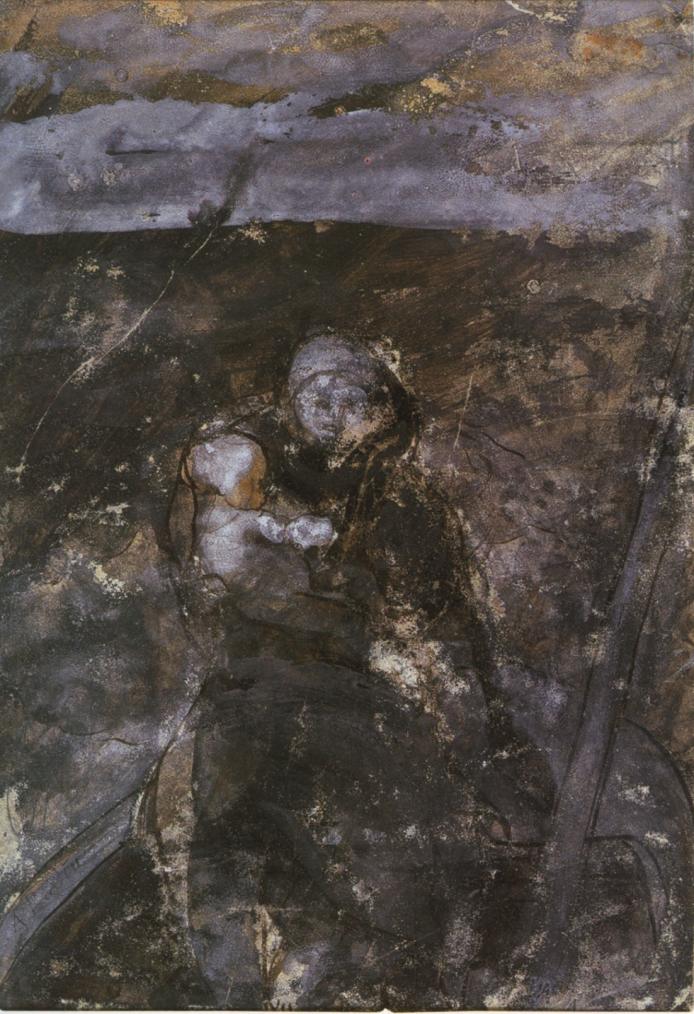Go to heaven for the climate,
Hell for the company
– Mark Twain
A few thoughts about heaven and hell and satan and such –
There is NO heaven and there is NO hell. Except when there is a heaven and a hell. One is aspirational and the other is to be dreaded and feared. As for the concepts of heaven they tend to fall within a narrower range than our concepts of hell. There are many kinds of hell, It doesn’t matter how real or how imaginary they are. They lie heavily on our minds and souls. Don’t get me started on souls. That is a whole other story. But hell seems to ‘exist’ for all thinking individuals and even for some who don’t think. There are the man-made constructs, as awful as the mind can imagine, fire and brimstone, eternal damnation, suffering beyond our wildest… Some hells as I noted are eternal. No hope. No second chance. Then there are the temporary assignments to hell, temporary often being eons long, but with a hope for redemption. There are the hells of the innocents whose transgression was an ignorance of a higher law. Who thought that one up?
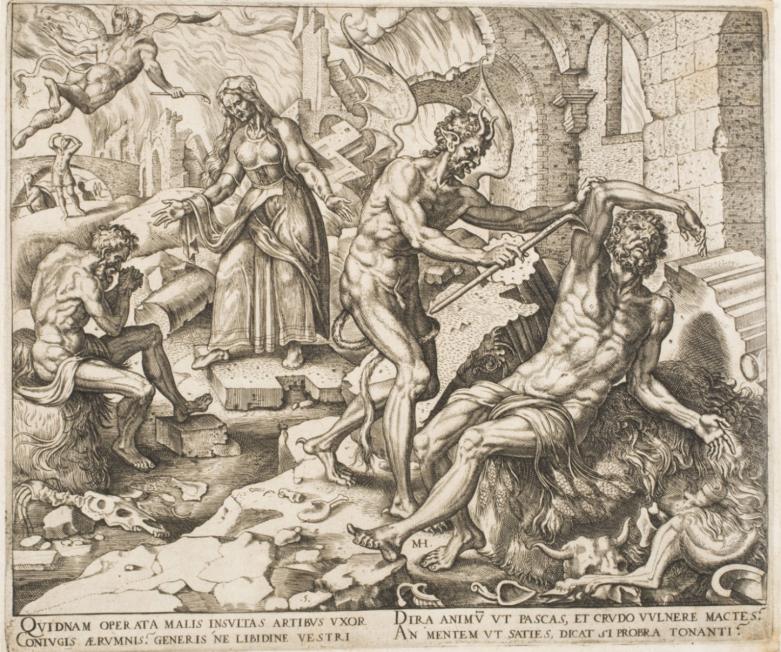
Satan inflicting boils on Job
Engraving by Phillips Galle (1537-1612) after the work of Maarten van Heemskerk (1498-1574)
Philadelphia Museum of Art
Harvey Silverglate, a civil liberties lawyer in Boston, has written a book entitled Three Felonies a Day. He argues, as I understand it, that the average citizen unwittingly breaks at least three laws in the course of 24 hours. He blames this as much on the increasingly rapid development of the Internet and cyber communications and laws meant to rein it in as anything else. If fact, someone overseas just this week called me on the carpet because they said I had broken a law promulgated in their country. I had transgressed in their eyes and for them there were no two ways about it. To them I am guilty. Who knew? Given the premise of this post I should be punished. But how severely and for how long? Who is going to sit in judgement of me? Who is going to administer my sentence? And if by some chance I am punished, then I would be living in my own mini-hell. I say ‘mini’ because compared to what others go through all of the time, my hell would pale by comparison to theirs.
One more point – for now: It is often said that there is no such thing as a perfect crime. Bulls**t! How many crimes go unsolved. Surely some percentage of them must. So the only way we humans can generally think that no evil deed will go unpunished is if 1) we believe in an all-knowing, all-powerful higher power or 2) barring that, that the perpetrator has any sense of a conscience, a still small voice. Sociopaths lack that voice, leaving us only to hope there is a God who will punish them for their crimes. If there isn’t then…
As usual I have picked a subject which is too big for my tiny brain. But, as in the past, this kind of thing never stops me – maybe because I am such a limited thinker and therefore don’t know any better. But for now join me and we will take a look at some of the enormous range of ‘hell’ topics. Clearly this will require more than a single post. So if we should all live long enough maybe, just maybe, we will get a sense of it – as disgustingly painful as that might be. Let’s start off with something juicy from Japan.
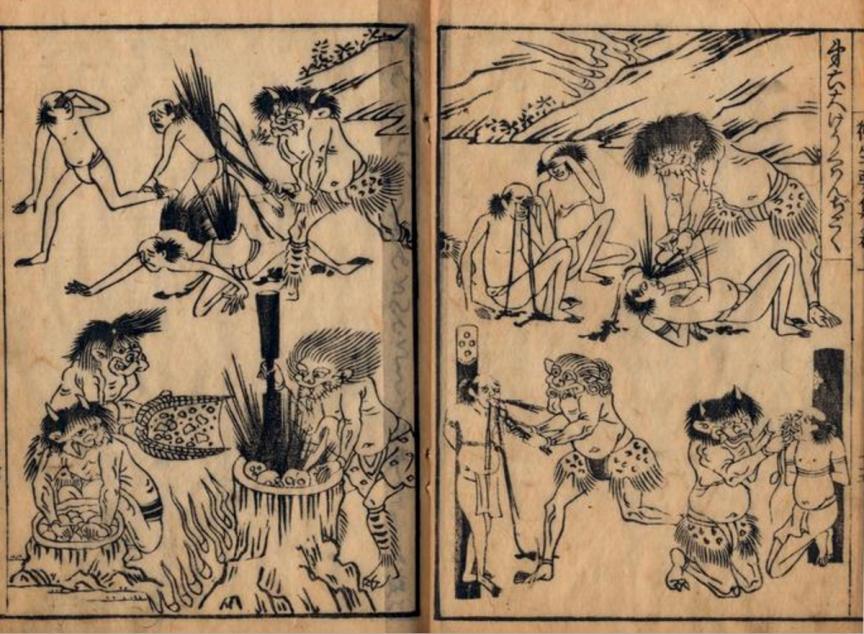
Two pages from the illustrated Ōjōyōshū (往生要集 – 1689)
by Genshin (源信- 942-1017) from the Lyon Collection.
It is important to remember that there isn’t just one hell in Asian belief systems. There are many hells. Not only that there are false heavens. These are places that are meant to deceive the soul of the deceased into believing they have found the right path when, in fact, they have been lulled into a false sense of ‘having arrived’. “In Bishamon no honji, the Golden Prince is said to have made it his constant practice to recite the nenbutsu, yet he is also said to have concluded that he “would certainly have entered” the third imposter paradise—a gateway to 80,000 different hells —“if not for Jizō’s instruction”.” This is what R. Keller Kimbrough wrote in The Pure Land in Medieval Japanese Fiction.
Now for something equally juicy from Europe.

The torments of hell – an anonymous Italian print ca. 1560 or later
British Museum
There, that should get your attention. But if it didn’t maybe this one from a European source might, just might, be of more interest to you – to your liking: Greek mythology.
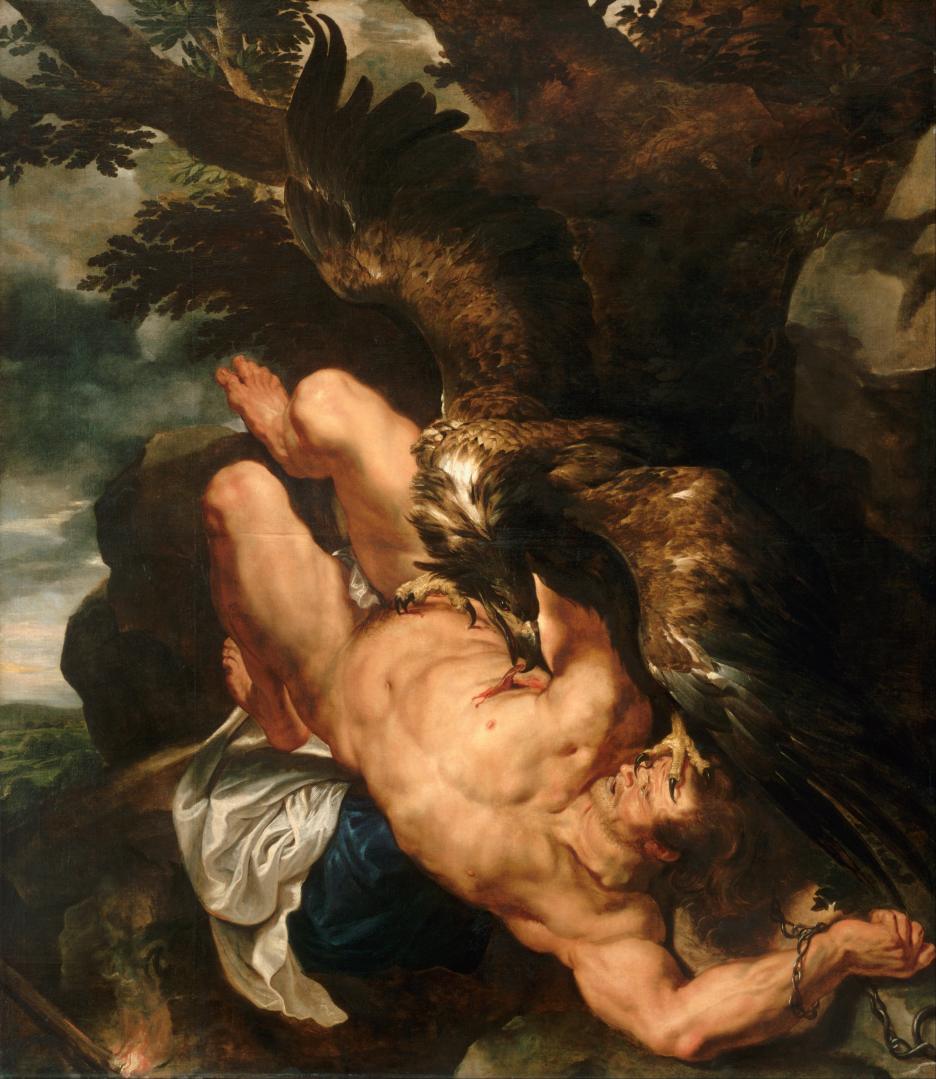
Prometheus – a collaboration between Ruben and Snyders
Philadelphia Museum of Art
Hades is the name of a place and a person – neither of them real –
“Hades, n. The lower world; the residence of departed spirits; the place where the dead live.” This is a quote from The Unabridged Devil’s Dictionary by Amborose Bierce, a very witty fellow.
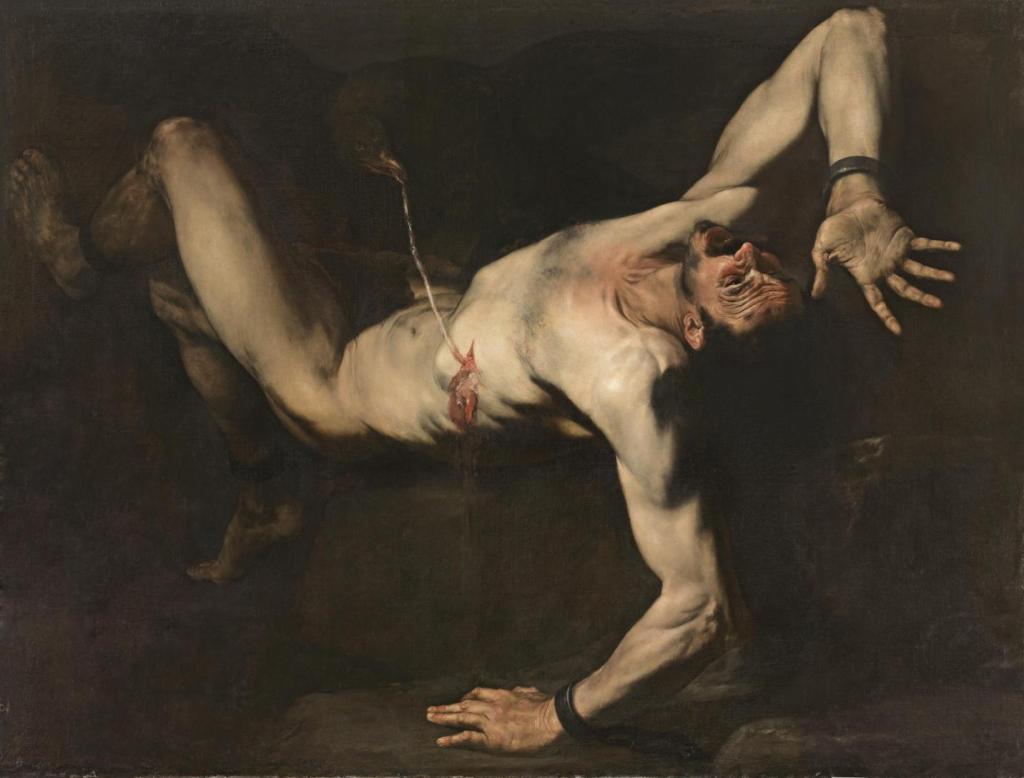
Ribera – 1632 – Tityus (Τιτυόν), the son of Jupiter and Elara, chained to a rock in Tartarus
having his liver pecked out by an eagle for all eternity
The Prado Museum
And I saw Tityus, son of revered Earth,
lying on the ground covering a vast area.
Two vultures sitting on either side of him tore into his body
and ate at his liver,
and his hands could not keep them off.
For he had assaulted Leto, the renowned consort of Zeus…
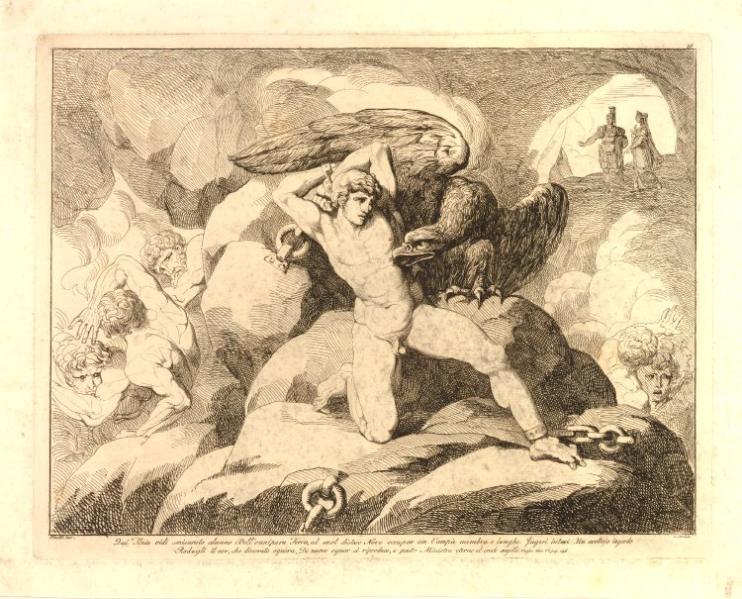
Etching of Tityus, ca. 1811. Aeneas and the Cumean Sibyl are seen in the upper right.
British Museum
What exactly is torture? Cees Nooteboom, a contemporary Dutch writer, tells about one over weight man who goes to a health spa and looks in at their gym facilities: ““Slaves were working out on torture machines. One young woman was running a Sisyphus-like race on a rubber belt that kept rolling round and round.”
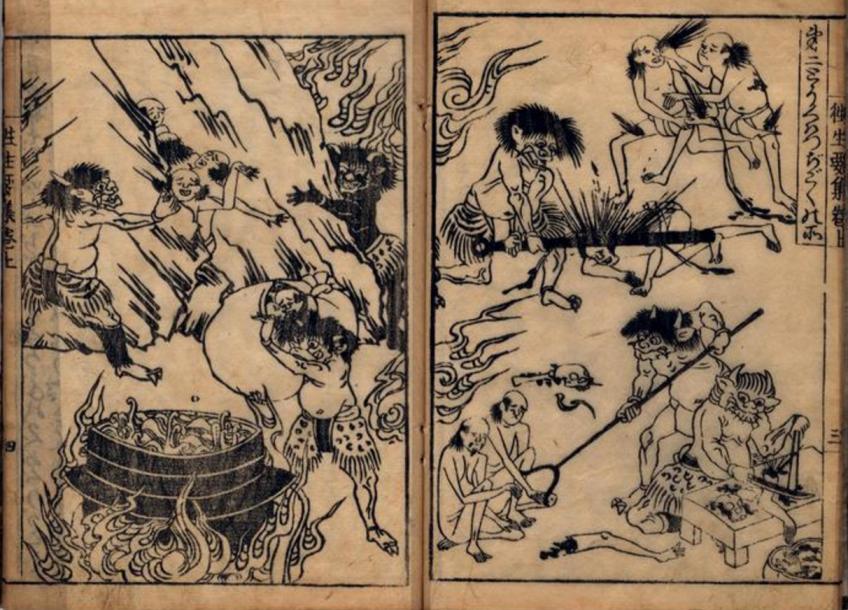
Lyon Collection
Charon (Χάρων) crossing the river Styx (Στυξ) –
To get across the river Styx a person had to have the appropriate funeral rites. In some cases a coin was to be placed under the tongue of the deceased as payment to Charon for taking the soul across to the other side. No coin, no ride.
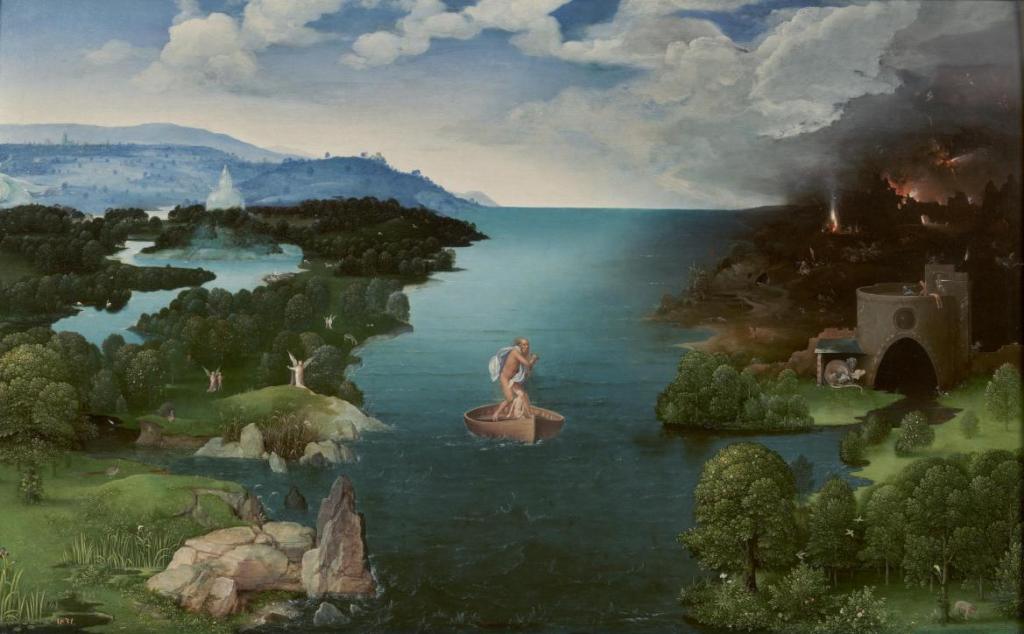
Joachim Patinir 1520-24
The Prado
Notice the tiny soul of the deceased being taken naked to the hell side of the river – on the right. While on the left side is the heavenly kingdom with angels. If only.
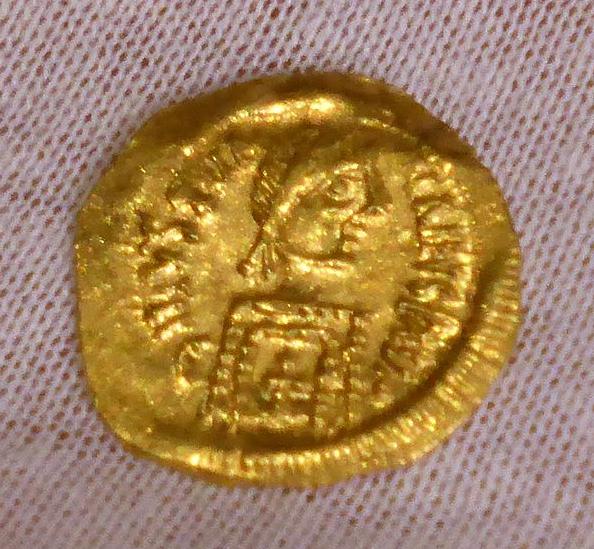
An obolus (οβολός) posted at commons.wikimedia by Ulrich55.
Right now I am metaphorically slapping my forehead. I say ‘metaphorically’ because I am not really doing that because I am typing, but if I wasn’t I would be. Why? Because, stupid me, I forgot that Achilles (Αχιλλεύς), one of the great, great, greatest heroes of all time died for two reasons: 1) hubris and 2) because his mother Thetis (Θέτις) dipped him as an infant in the River Styx to make him invincible. Except, forgetting that she had left his ankles vulnerable by holding him there, and this became his Achilles heel. The most human and exposed spot on his body. And who killed him? Paris, who shot an arrow into that spot. Now that is justice for you. The gods had a rivalry which causing Paris to abduct Helen. The Greeks sought revenge. Achilles, a Greek, wrecked havoc on the Trojans and Paris did the same to him. What a mess. What a tragic, tragic mess.
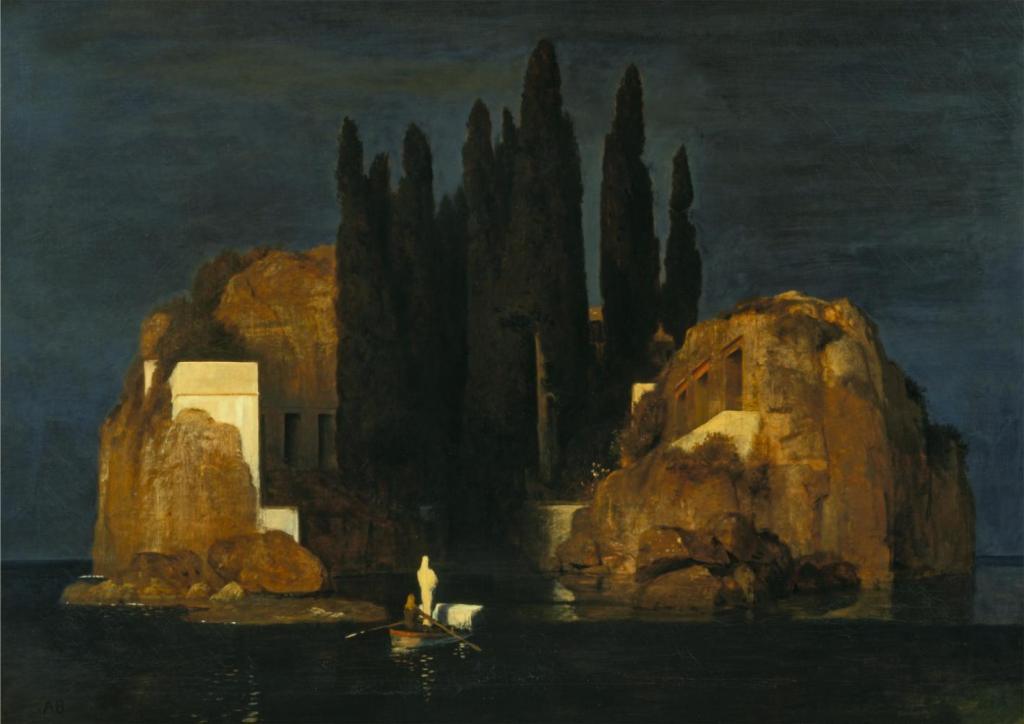
Böcklin’s 1880 Isle of the Dead
The Kunstmuseum Basel
Böcklin never explained the imagery in this painting. In fact, actually as I recall, he didn’t even give it a title. It was one of his dealers who called it Die Toteninsel. Makes sense to me. But… my point: he doesn’t tell us that the oarsman is Charon, while on the other hand he doesn’t tell us he isn’t.
Auguste Rodin gave us a non-traditional Barque of Charon. Is that a baby in the ferryman’s arms? Looks like it.
Orpheus (Ὀρφεύς) – Orpheus and Eurydice – Orpheus and Cerberus – Orpheus et al.
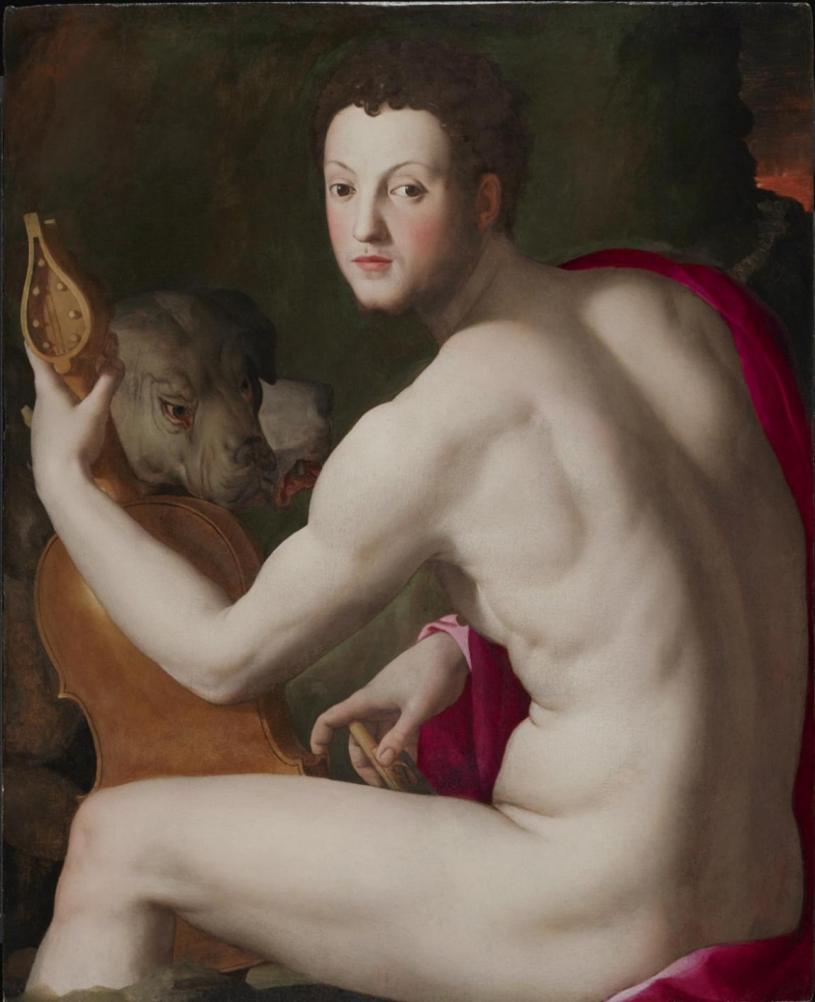
Cosimo I de’Medici (1519-74) as Orpheus lulling Cerberus at the entry to Hades by Agnolo Bronzino
Philadelphia Museum of Art
Bronzino painted many portraits of Cosimo, but this is the earliest one and and the only one where he appears so flagrantly in the buff. He probably kept it in his private chambers for only a few of his closest family and friends to see. At first when I was looking at it I thought “No way!” Surely Bronzino has painted Cosimo’s head on a more idealized body. We do know that this pose is supposedly based on the Belvedere Torso in the Vatican Museum. I thought, maybe this is like the time the publishers of the TV Guide put Oprah Winfrey’s head on Ann-Margaret’s body on the cover of one of their issues, the one appearing in the last week of August 1989. But then I read a bit more about Cosimo and discovered – probably not for the first time – that after his distant cousin Alessandro, the duke of Florence, was assassinated Cosimo rushed to Florence with a few friends and seized power. Shortly after that he fought off an attempt by the Strozzi family to rule that great city. So, maybe he was more fit than one would expect and could have posed for this image. We also know that he fancied himself a poet. Hence the connection with Orpheus who lulls Cerberus the guardian of gateway into Hades, the underworld. Here Cerberus is the two-headed dog in the background.
We also know that Orpheus, the son of Calliope (Καλλιόπη) and either Oeagrus (Οἴαγρος), the king of Thrace, or Apollo – sources differ on this one and there were no DNA paternity tests available to either ancient mortals or the gods – anyway, we know that Orpheus serenaded Charon into taking him across the river Styx to the entryway into hell. And why was Orpheus so hell-bent on getting their? He wanted to retrieve the soul of his deceased wife Eurydice. But more about that later.
Orpheus was such a great performer that even inanimate objects like rocks and trees were moved by his music. Aeschylus wrote: “He led all things by the rapture of his voice…”
In Act 3, scene 1 of Shakespeare’s Henry VIII queen Katherine (of Aragon) says to one of her ladies: “Take thy lute, wench: my soul grows sad with troubles; Sing, and disperse ’em, if thou canst: leave working.” The song is this:
Orpheus with his lute made trees,
As the mountain tops that freeze,
Bow themselves when he did sing:
To his music plants and flowers
Ever sprung; as sun and showers
There had made a lasting spring.
Every thing that heard him play, (10)
Even the billows of the sea,
Hung their heads, and then lay by.
In sweet music is such art,
Killing care and grief of heart
Fall asleep, or hearing, die.
e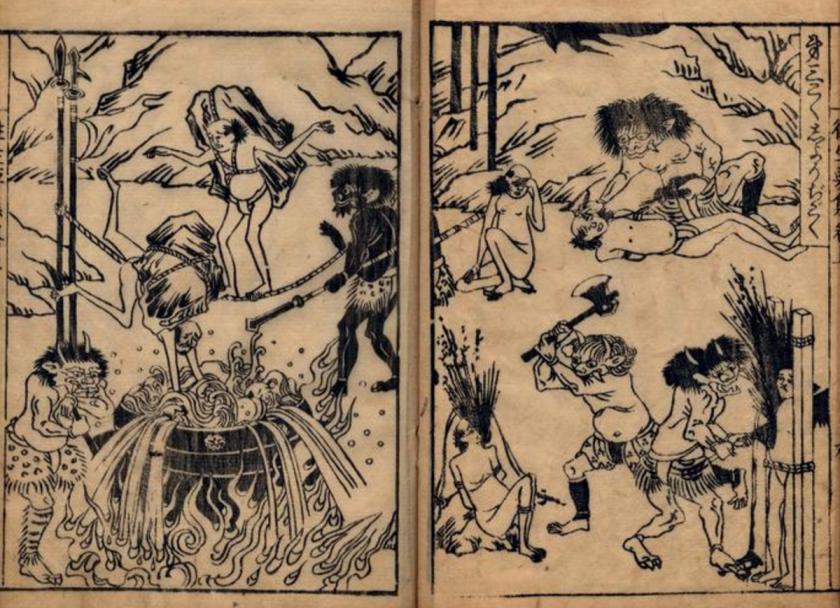
Lyon Collection
The King of Hell sitting in judgment –
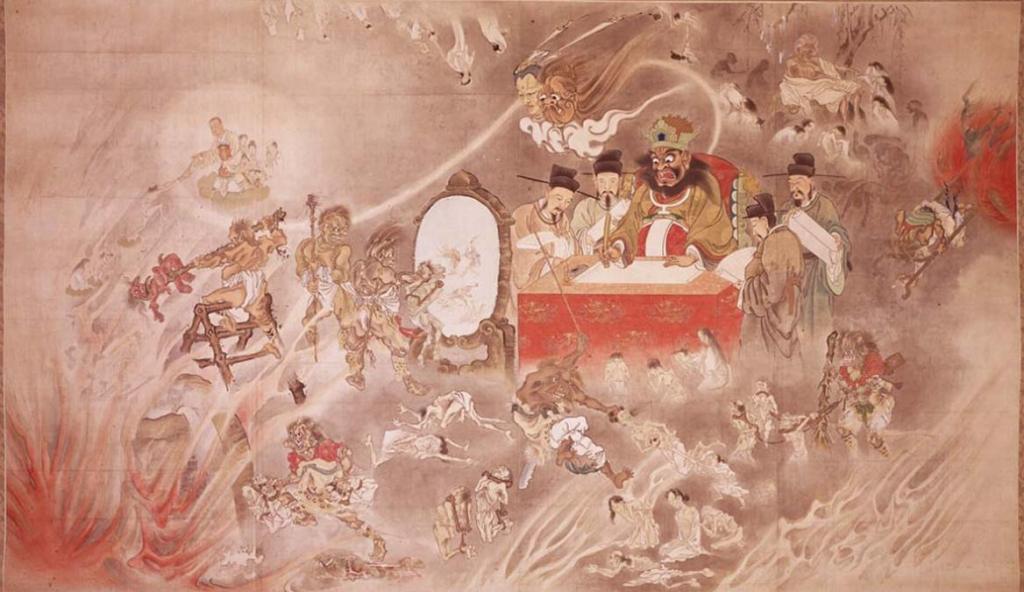
Kyōsai – Tokyo National Museum
Hell scene tattoos –

Yoshitoshi 1860 figure with an elaborate tattoo
Los Angeles County Museum of Art
If you look closely at his shoulder you will see two disembodies heads on top of Emma-ō’s staff. They are Miru-me and Kagu-hana (見る目嗅ぐ鼻), one can see all evils and the other can smell the stench of past events. The karmic mirror is placed behind them. Below them on the man’s body is a demon by the fiery hell carriage. Notice that all of these elements appear in the painting by Kyōsai in Tokyo shown above.
Sometimes it is best if you just fight back – in your dreams Jack!
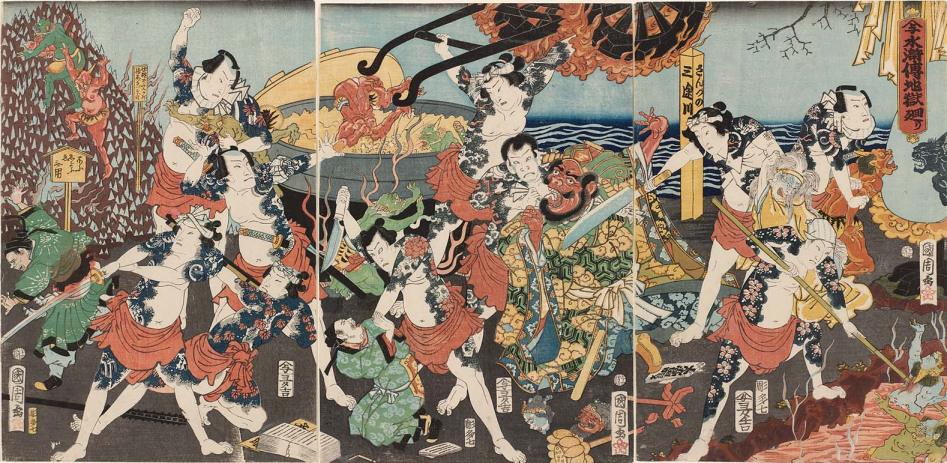
Kunichika – 1864 – Suikoden Heroes in Hell (水滸伝地獄回り – Suikoden jigoku meguri)
Museum of Fine Arts, Boston
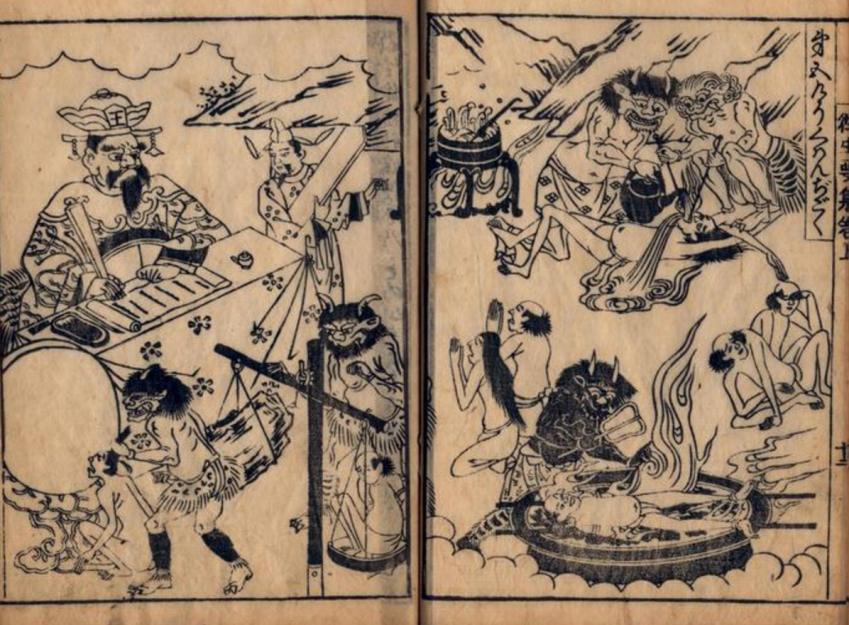
Lyon Collection
Satan in the Old Testament: The Book of Job
In Chapter one of The Book of God the angels of God assembled and among them was Satan. Some think he was His favorite. God asked Satan what he had been up to and Satan responded that he had been down on earth walking about. God asked him if he had seen Job, his most obedient servant. Satan said he had seen him, but was not sure sure Job would be so obedient if he wasn’t protected so lovingly by God. So God and Satan made a wager. Satan could do what he liked to Job, but he must not hurt him.
With that Satan went down to the earth and wrecked havoc on all of Jobs children and possessions until nothing was left, but Job still loved God unquestioningly. When Satan reported this back to God, God said basically “See, I told you so. He is a good and obedient man.” We are now in Chapter 2. With that Satan said something like “Don’t be so sure God. Would he be so God-adoring, God-fearing if Job himself was afflicted?” So, they upped the ante. God told Satan he could go down to earth again and inflict harm on Job, but he was not to kill him. Below and at the top of this page we see Satan doing what Satan does best – making people miserable. Even Job’s wife doesn’t understand how her husband can remain steadfast and true in his belief that God is good. Personally I tend more toward the wife’s point of view.

From Le Miroir de l’humaine salvation – 15th century
Musée Condé, Chantilly
7 Then Satan left the Lord‘s presence and made sores break out all over Job’s body.
8 Job went and sat by the garbage dump and took a piece of broken pottery to scrape his sores.
9 His wife said to him, “You are still as faithful as ever, aren’t you? Why don’t you curse God and die?”
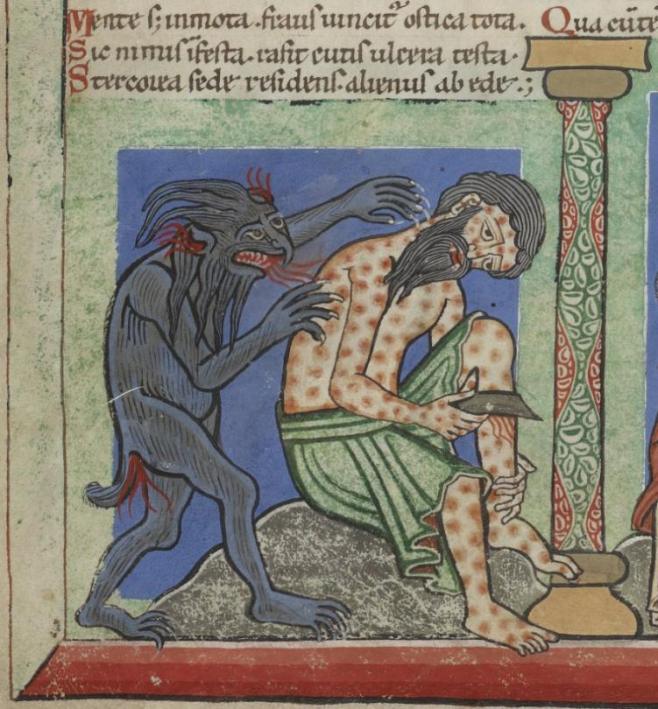
Flemish illumination – this is a detail from the lower left corner of a larger sheet
Late 12th century
Bibliothèque nationale de France
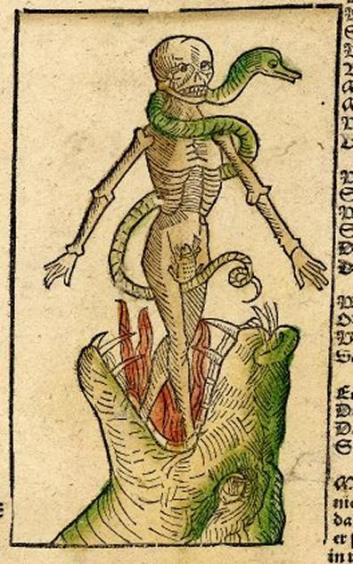
Sinner in the jaws of hell – German ca. 1490-1500
This is a detail from a broadside in the British Museum.
David Jeffrey in A Dictionary of Biblical Tradition in English Literature wrote: “The classic elements of Christian diabology… were established by Origen and St Augustine (354–430) and were popularized in the West by St Gregory the Great, especially in his Moralia in Job. In Gregory’s account, God created the angels good and gave them free will. Lucifer, one of the highest angels, sinned through pride and envy, choosing his own will over God’s, and he led many of the other angels after him (these became the demons). Envious of God’s love for humanity, Satan used the serpent to tempt Adam and Eve to transgress his divine ordinance. God punished fallen humanity by leaving it in the devil’s power, though this power was ultimately limited by God’s sovereignty. In his mercy, however, God the Father sent God the Son to liberate humanity from this slavery to Satan.”
And what about Dante and his damned Inferno?
…for the only true paradise is always
the paradise we have lost.
Marcel Proust
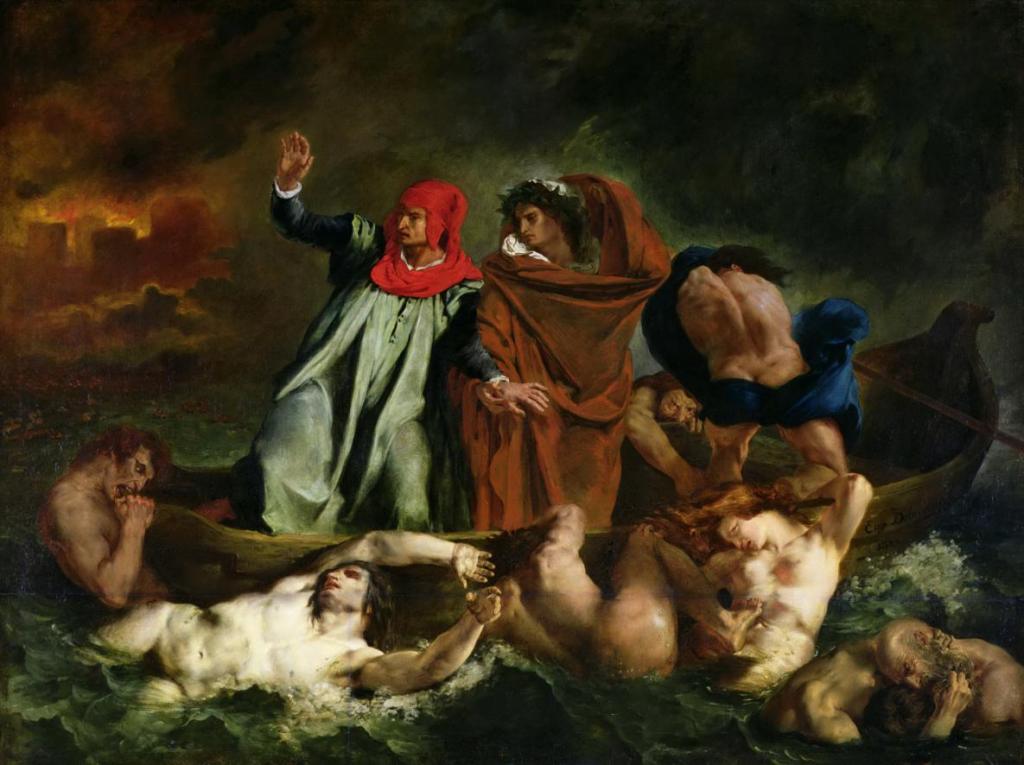
The Barque of Dante by Delacroix
The Louvre
Is hell a reality or a metaphor? What about hell on earth? Aleppo? Or…
Hell is empty, and all the devils are here.
Ariel in The Tempest, Act One, Scene 2
William Shakespeare
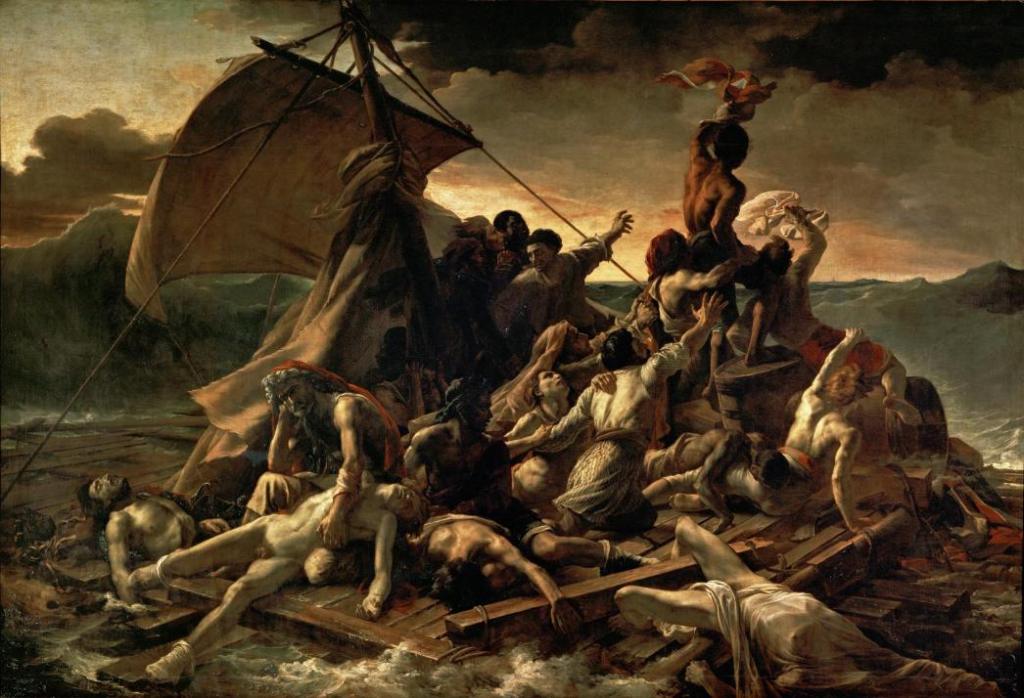
Raft of the Medusa by Gericault
The Louvre
If you want to know how to get to hell, just ask Siri.
I think we all know what helps land a soul in hell. It is sin, sin, sin. Add guilt and shame to these and there you have – a sure fire way to eternal damnation. But the question is “What exactly is sin?” Now generally I think we can agree on the most glaring particulars, but it is the parsing of the fine points that are problematical. For example, what an old codger would consider sinful and millenial might be two completely different things. What the old codger would consider disgusting thoughts and behavior driven by lust, the millenial might think of as simply human nature, natural and, dare I say it, fun. Disgusting behavior vs. fun.
Once, when asked a question, under oath, Bill Clinton said: “It depends on what the meaning of the word is is.” Say what? With that one simple thought all solid ground fell away beneath our philosophical underpinnings. “…what the meaning of is is” means that everything is, and I do mean everything, is relative. For example, if asked what the meaning of sin is one could say “That depends…”
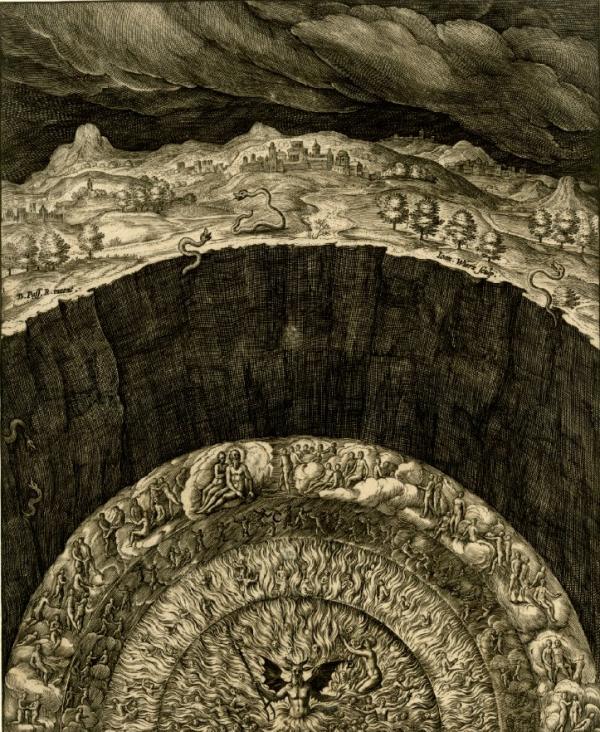
Engraving by Wierix after Passeri showing the circles of hell.
The British Museum
If you think it you might as well do it! Wrong-o! It is one thing to think about committing a sin or a crime and it is another thing to act on those thoughts. However, Sir Walter Raleigh (ca. 1554-1618) once said that the “true divinity” knows that a persons evil desires are actually the same as their sins. Gregory the Great (ca. 540 – 604) had said the same thing before Sir Walter, a thousand years before: “For what man’s heart, whilst bound up with this corruptible flesh, does not slip in ill bent thought…. And yet to think these same wrong thoughts is to commit sin.”
Carol Kaske points out that this paradox between thought and action implies that all morality is self-defeating. That is, according to me, only if you buy into such concepts.
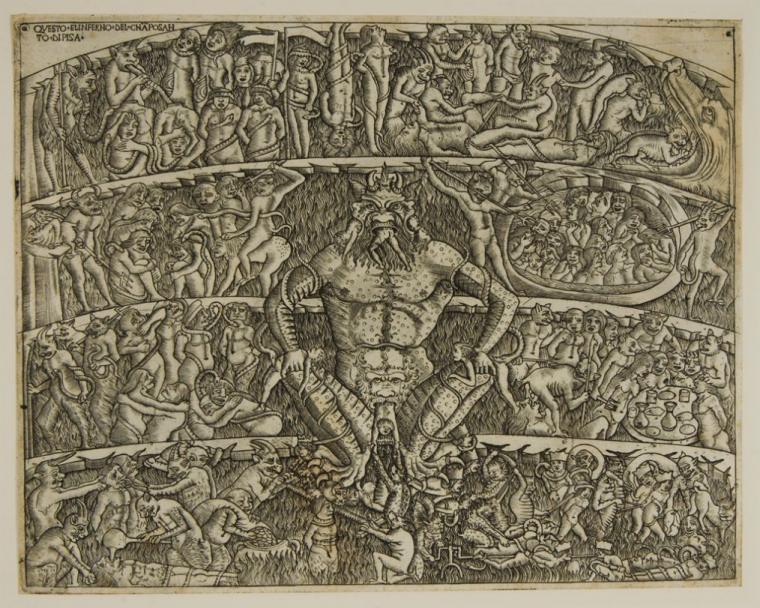
Satan in his realm [my title] – 1499
Harvard Art Museums
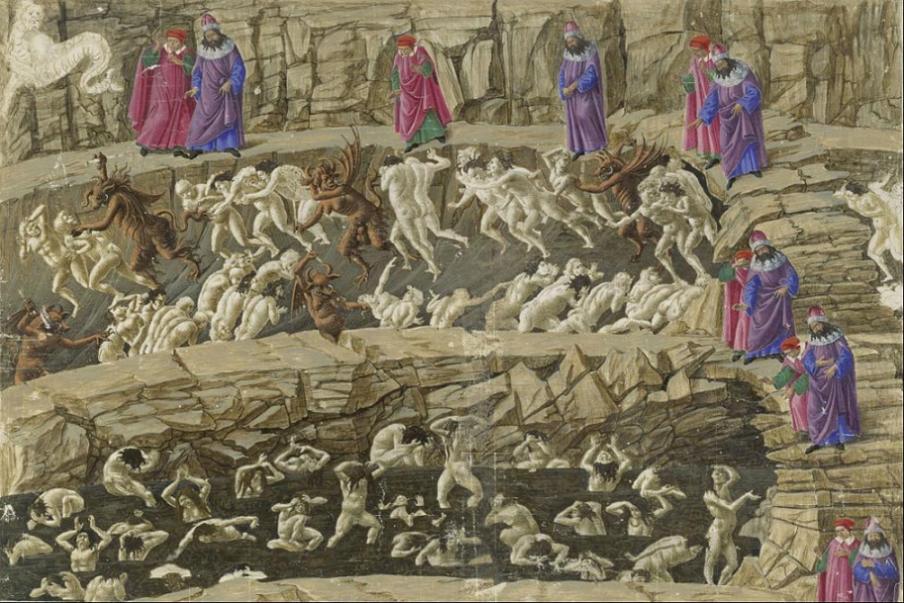
Sandro Botticelli illustration of Dante’s visit to hell
Kupferstichkabinett, Berlin
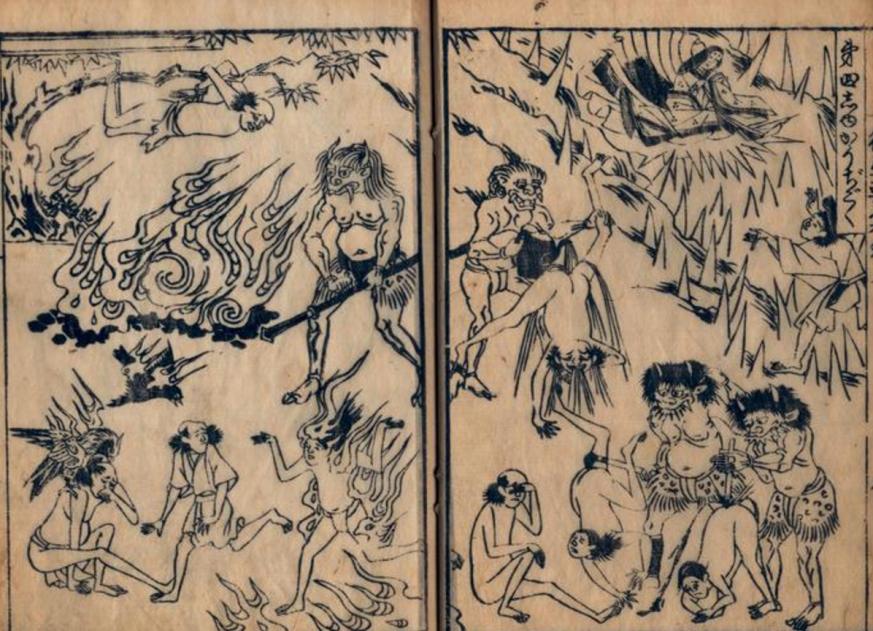
Lyon Collection
The Harrowing of Hell – Descensus Christi ad Infernos – The Gospel of Nicodemus
Nicodemus is first mentioned in John 3:1 –
There was a man of the Pharisees named Nicodemus, a ruler of the Jews. 2 He came to Jesus by night and said to Him, “Rabbi, we know that You are a teacher who has come from God. For no one can do these signs that You do unless God is with him.”
3 Jesus answered him, “Truly, truly I say to you, unless a man is born again, he cannot see the kingdom of God.”
4 Nicodemus said to Him, “How can a man be born when he is old? Can he enter a second time into his mother’s womb and be born?”
5 Jesus answered, “Truly, truly I say to you, unless a man is born of water and the Spirit, he cannot enter the kingdom of God. 6 That which is born of the flesh is flesh, and that which is born of the Spirit is spirit.7 Do not marvel that I said to you, ‘You must be born again.’ 8 The wind blows where it wishes, and you hear its sound, but you do not know where it comes from or where it goes. So it is with everyone who is born of the Spirit.”
It is from this passage that the legend about Nicodemus grew up and the eventual medieval text known as The Gospel of Nicodemus. It was a late addition to another apocryphal text, the Acta Pilati or the acts of Pilate. None of these works are now considered original to the New Testament, but that did nothing at the time to stop the mythologizing of Nicodemus and ‘his’ tale. That is why he along with Joseph of Arimathea are often seen taking the lifeless body of Jesus down from the cross. Joseph, too, is mentioned in the New Testament because he was said to have gone to Pontius Pilate and asked permission to take the body off of the cross and to be allowed to bury it.
Below is a painting by Rogier van der Weyden from the Prado showing Nicodemus, probably the old man in the red skull cap, helping lower the body. Joseph of Arimathea is thought to be the man in gold on our right.
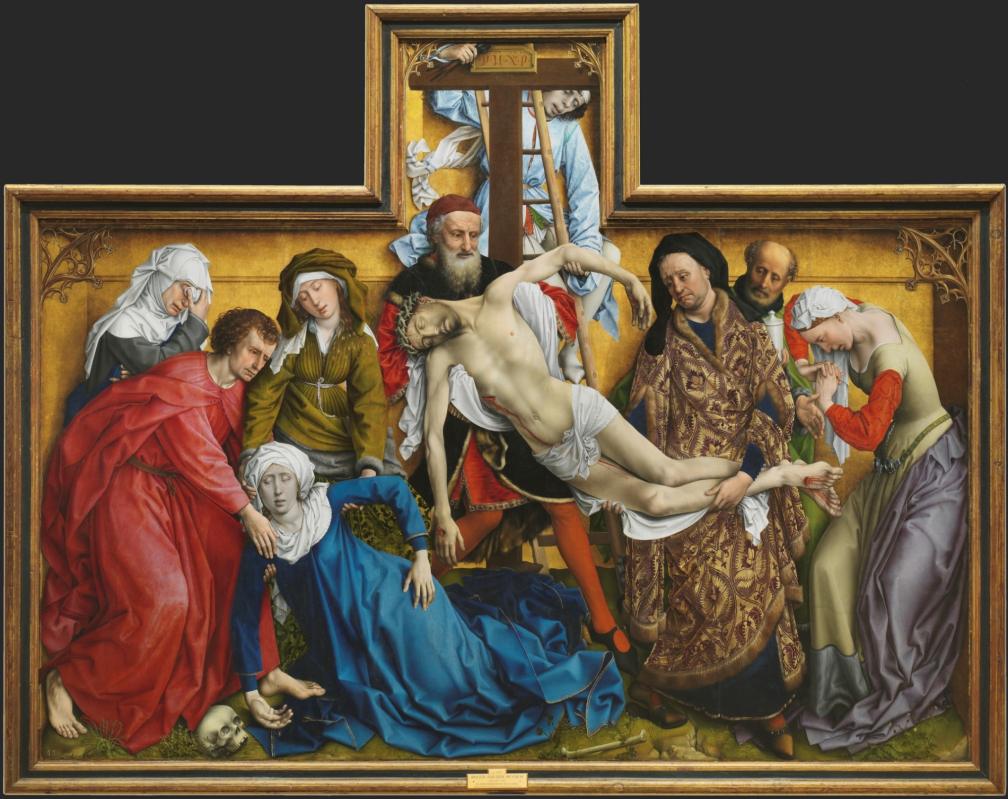
Descent from the Cross – before 1443
Rogier van der Weyden – The Prado
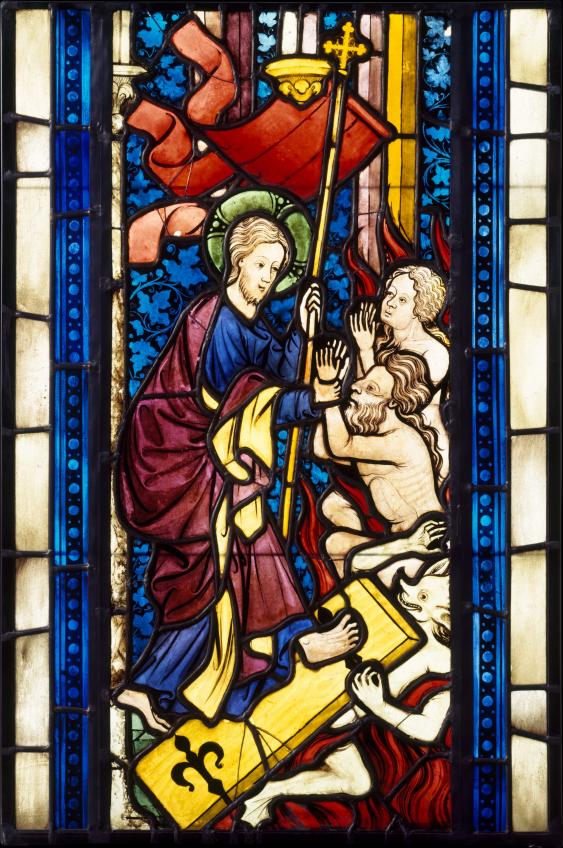
Austrian stained glass window from Ebreichsdorf Castle – ca. 1390
The Harrowing of Hell – aka Christ’s Descent into Limbo (or Hell, if you like)
The Cloisters
Ebreichsdorf Castle, a few miles south of Vienna, was used as a line of defense against the Mongols in 1380. It was plundered by the Turks in 1683. No wonder they wanted and celebrated the life of Jesus in the chapel which was added to the ancient to the castle. It’s a miracle any of them survived. Hallelujah!
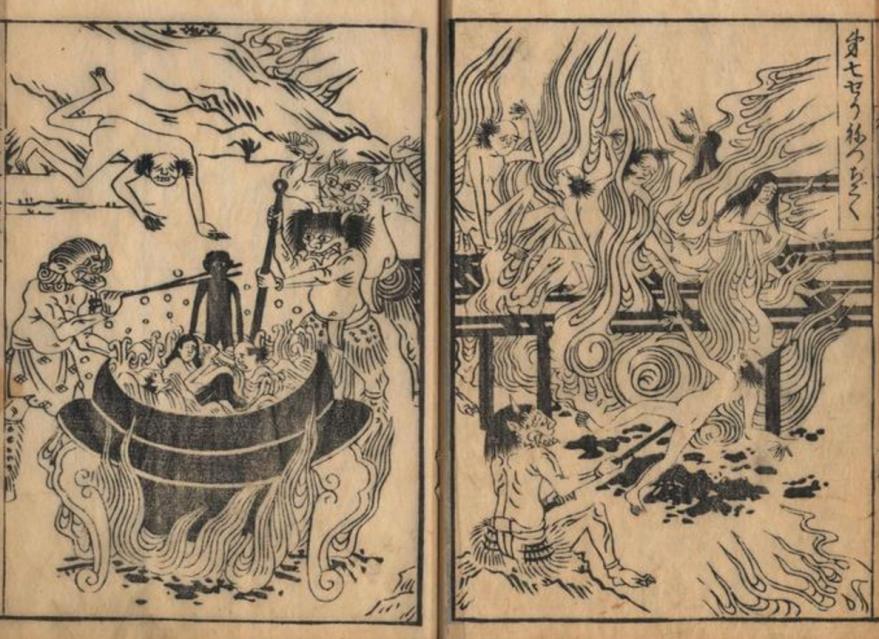
Lyon Collection
There is a hell in the Islamic world too, but only the Shia would create images related to it. That is how we found a 16th century page from a Safavid manuscript, the Chain of Gold. It is a beautiful painting with many different elements, but it is the image in the lower left corner which shows a dark-skinned, bearded figure of Satan who is chastising a man who is sodomizing his camel which is most startling. Clearly this is one of those actions that can damn a person for the rest of eternity.
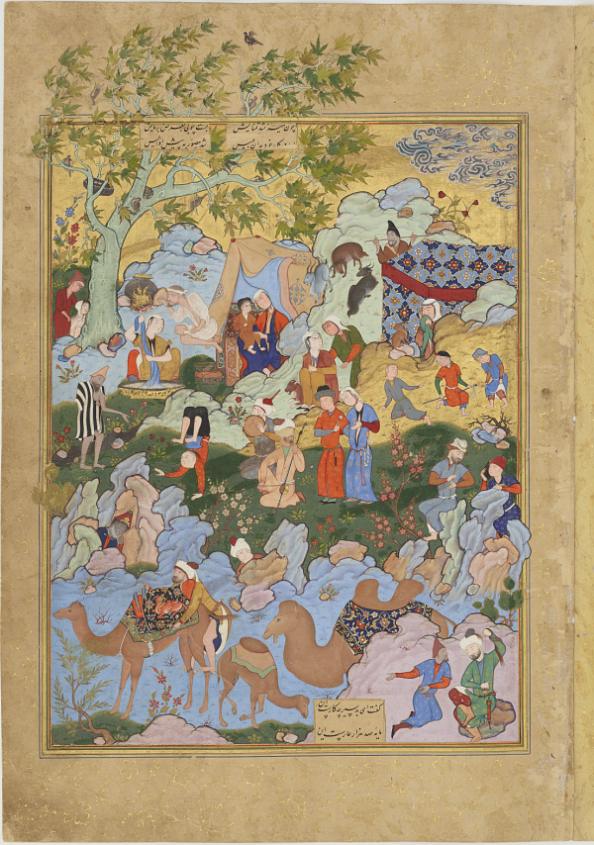
Freer Sackler Galleries

The Hell Courtesan or Jigoku dayu (地獄太夫) –
I know we can trace one thread of the story of the Jigoku dayu back to the 14th century when the priest Ikkyu (1394-1481), the bastard son of the Emperor Go-Kamatsu, adopted a beautiful courtesan from Takasu and showed her the error of her ways. Ikkyu is the same priest who used to go around carrying a skull at the top of his staff to remind people of how impermanent life is.

Chikanobu (1838-1912)
Museum of Fine Arts, Boston

Kiyochika (清親: 1847-1915)
The Hell Courtesan – 1884 – detail
Ritsumeikan University
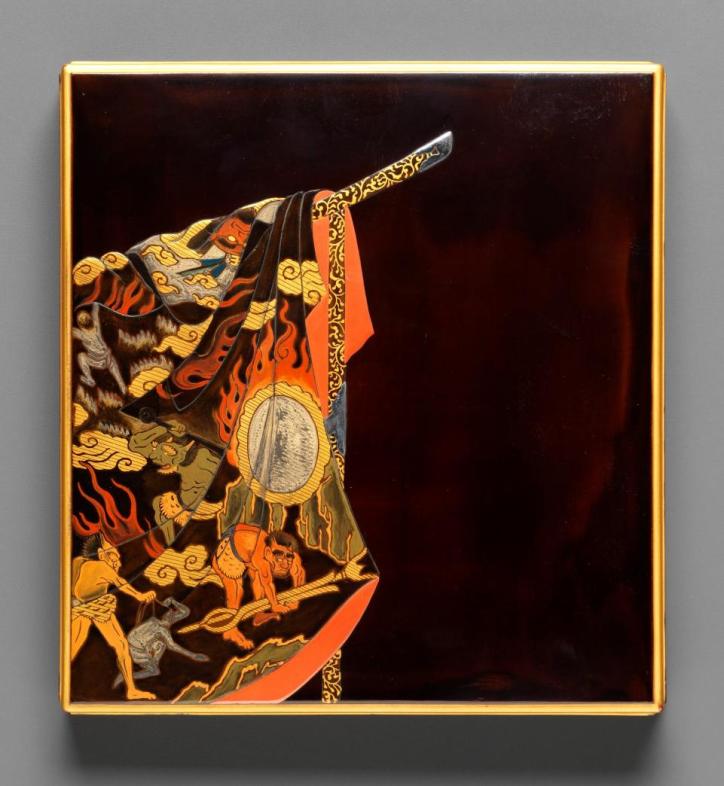
The Hell Courtesan’s robe hangs on an ikō (衣桁) or clothes rack.
This is a lacquer decoration on the lid of a writing box
or suzuribako (硯箱) dating from ca. 1860-70.
Museum of Fine Arts, Boston

Kyōsai – 1870s to 1880s
Museum of Fine Arts, Boston
There was a one playwright named Kawatake Mokuami (1816-93) who did more to modernize the kabuki theater than any other man in Japan. One of his plays, Jigoku Ikkyū banashi (The Story of Ikkyū and Jigoku) is a prime example in which he took an old theme and put a new twist on it. In this play Ikkyū visits a brothel and starts dancing with the women who work there to the accompaniment of a shamisen performer. Jigoku also works there, but has not joined in the frivolity. When she hears the others having such a gay old time she peeks out from behind a screen and is startled to see that only Ikkyū is made of flesh and blood while all of the others are now skeletons. Then when she walks out to join them the skeletons all turn back into living souls. A dream or powerful allusion to the fine line we hold onto while we are living and breathing when death is always near?

Detail from the robe of another version of a painting of the Hell Maiden by Kyōsai
from the Cleveland Museum of Art
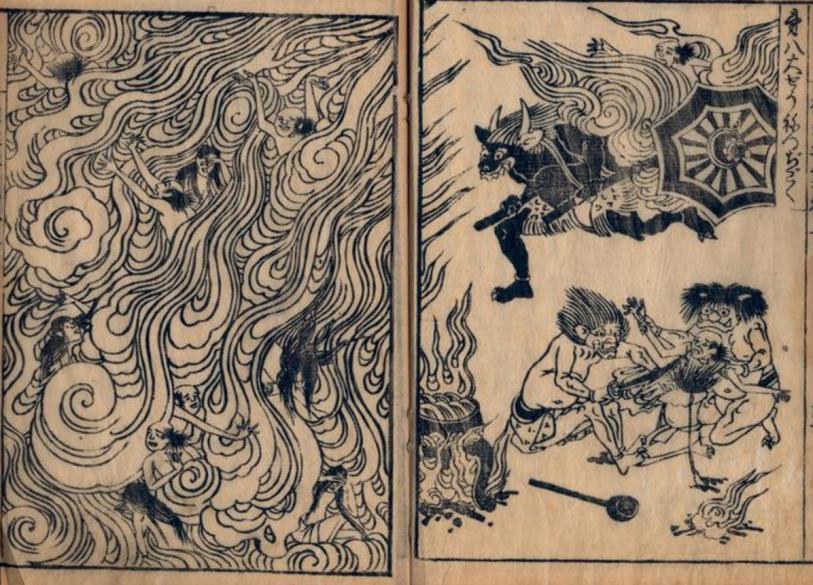
Lyon Collection
The Last Judgment!
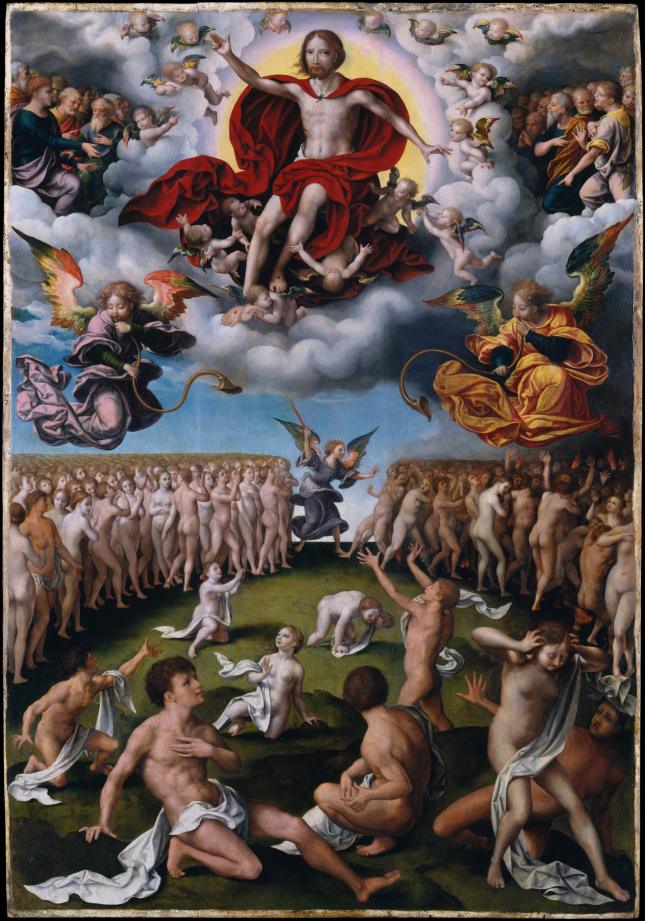
The Last Judgement
Attributed to Joos van Cleve (ca. 1485-1540/41) – ca. 1520-25
Metropolitan Museum of Art
Maryan Ainsworth wrote about this painting in 1998 that it could just as likely been displayed in a church as in a city hall:
“In this beautiful and ambitious composition, the upper and lower zones are linked by two angels with fantastic
multicolored wings and swirling mauve and yellow-orange garments who are blowing lily-shaped trumpets, their
cheeks swelling with their considerable efforts. Christ appears at the moment of judgment in a burst of light and
color, surrounded by voluminous clouds, apostles, and a host of angels and putti with rainbow-hued wings. The
sunburst may have been inspired by the artist’s close reading of Saint Augustine’s City of God (Book 20: chap. 27),
in which the author speaks of “that sun of righteousness” who brings “the brightness of eternal life” and quotes
Matthew (13:43) describing the time of the Last Judgment when “the righteous [shall] shine forth as the sun in the
kingdom of heaven” (Book 20: chap. 1). The effect of this blinding radiance and variegated color in the upper part of
the composition is in sharp contrast to the subdued tones in the area of the mass of humanity pictured below. Christ
blesses the saved, shown at the left, and, with the assistance of Saint Michael in the lower register, he banishes the
damned to the hell burning in the distance at the right.”
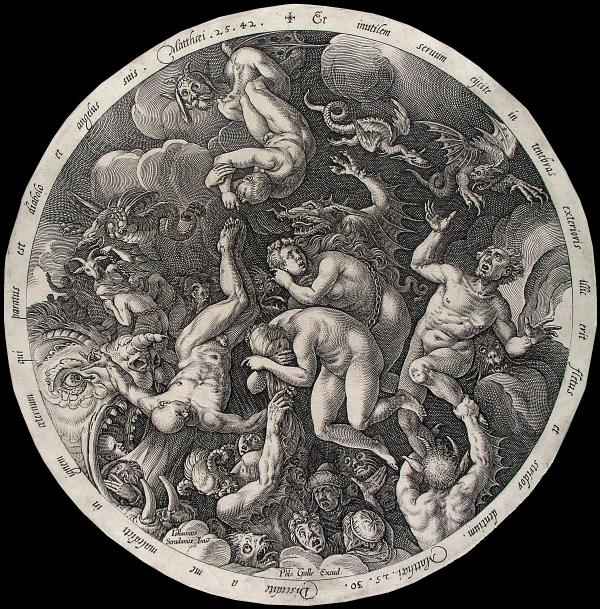
Descent of the Damned into Hell – from the Last Judgment – ca. 1577
Hendrik Goltzius (1558-1617) after a work by Jan van der Straet (1523-1605)
Goltzius is one of my favorites. Did you know that… “Goltzius began his career as a printmaker and, despite the handicap of a withered hand, became such a virtuoso as to be able to imitate the style of all the major figures of the past. His own personal contribution was a technique of modelling form with systems of intersecting arcs, which swelled in thickness towards the centre; when allied to the bombastic mannerist style of composition which he had learnt from Bartholomeus Spranger, this produced prints of unparalleled visual splendour.” He gave up engraving in 1599 and turned to painting. But it is his brilliance as an engraver… Wow! And with a withered hand, no less. (This is quoted from Prints and Printmaking…. by Anthony Griffiths.)
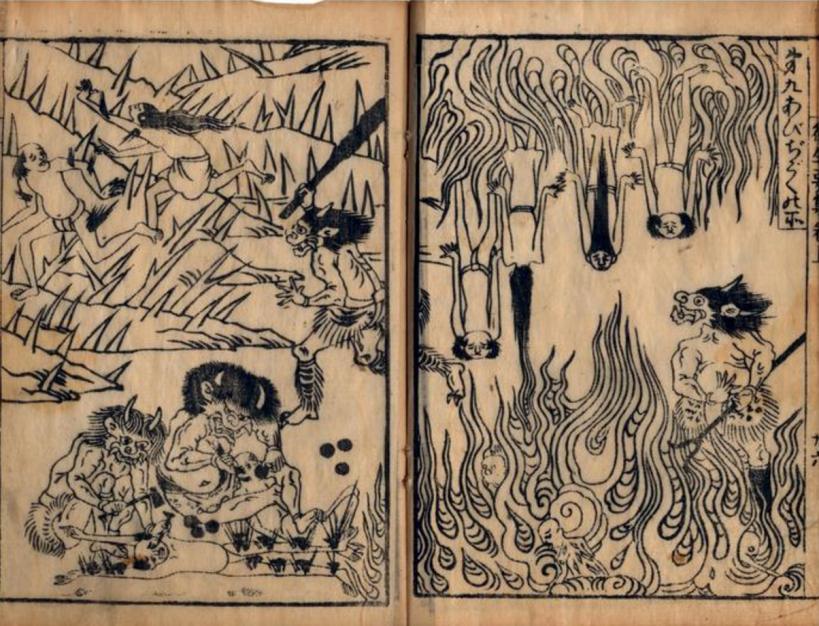
Lyon Collection
Hell as political satire –
In the first satirical print shown below Napoleon is sooooooo bad that even hell doesn’t want him. When the devils saw him approaching they cried out:
Turn him out of Hell – turn him out of Hell or else he’ll ruin all
Napoleon responds:
I am come to make you all free & happy!
Two of the devils cry out:
Get you gone. You have cheated the Dutch & Italians;
therefore Master says he’s afraid you may take him in too!!

Isaac Cruikshank – 1803
The Devil won’t take him; What a pity!!!
British Museum
But by 1808 the mood had changed. Below a caricature shows Satan is guiding the emperor into the jaws of hell while distracting him by the glories and prospects of the sun of the West Indies.
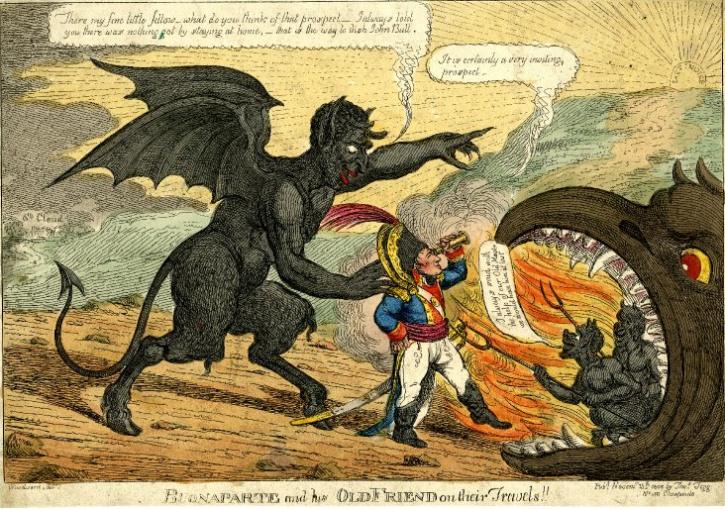
Buonaparte and his Old Friend on their Travels!!
1808 – British Museum
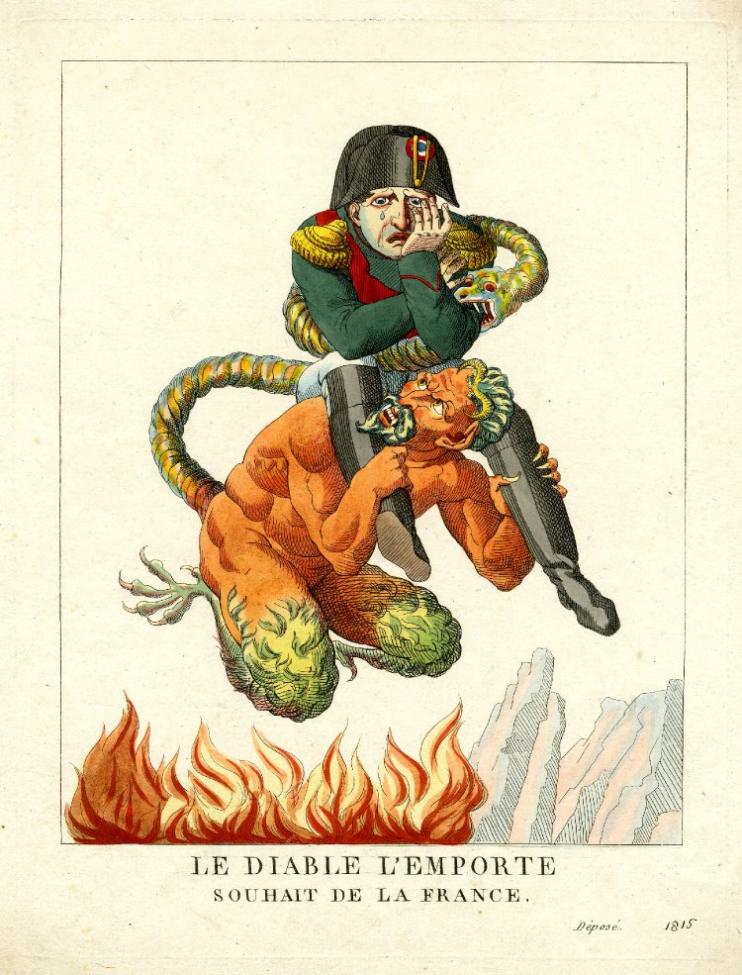
The Devil Prevails
British Museum
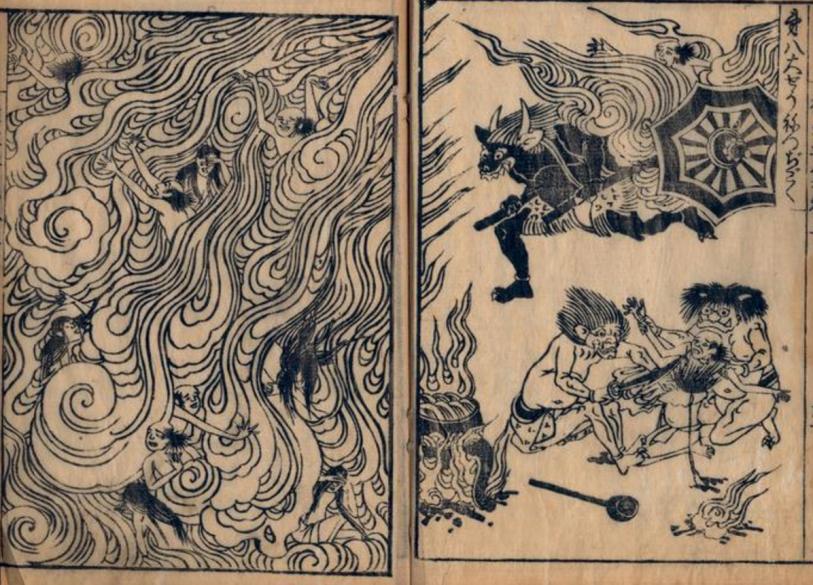
Lyon Collection
THIS IS AN ON-GOING PROJECT.
BASICALLY I HAVE FINISHED ADDING IMAGES TO THIS PAGE,
BUT WILL ADD TEXT FROM TIME TO TIME. THEN EVENTUALLY
I WILL ADD MORE HELL POSTS BECAUSE THERE IS MUCH MORE
GROUND TO COVER, GROUND ON WHICH
WE CAN SUFFER TOGETHER COMPADRE.
THANKS!
